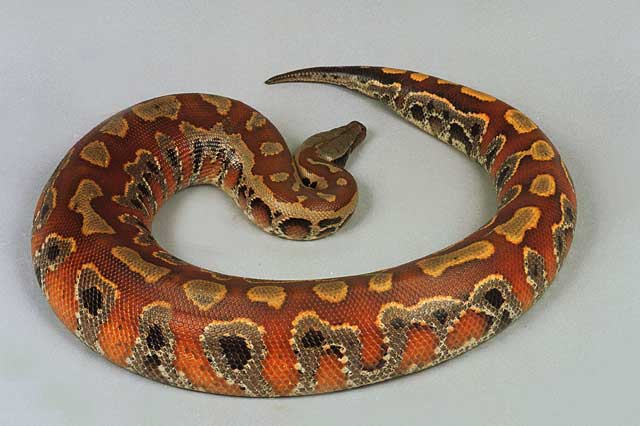Python - Sumatra Blood
Sumatran Blood Python, Red Blood Python, Malaysian Short-tailed Python Scientific Name: Python curtus brongersmai
Sun, 24th November, 2024 - 8:34 am GMT
Sponsor Ads:

Alternative Name
Sumatran Blood Python, Red Blood Python, Malaysian Short-tailed Python Scientific Name: Python curtus brongersmaiBasic Info
The Sumatra Blood Python gets its name from the blood red color that washes over its skin. They are also dusted in light yellows and oranges and have thick bodies, perfect for constricting.
Health
Sumatran Blood Pythons should be kept at tropical temperatures and humididty levels. Sumatra Blood Pythons are prone to respiratory infections if the humidity or temperature are not suitable for it. They will be shown as fluid in the mouth and nostrils of the snake, who will have an open, gaping mouth. Dry sheds due to inappropriate temperature and humidity or illness and stress are also a problem. Provide a very large dish of fresh water at all times, as these snakes need to soak in addition to drinking. Be warned that they might be picky eaters; some of them will only eat with the lights out and some of them have to "hunt" their prey first, although it is best to feed them killed, frozen prey to avoid injury or parasite infection to your snake. Breeding These snakes become mature very fast and take a mate within the first three years of their lives, usually after they have grown past four feet or so. They breed during the winter months when in captivity. They need to be left alone during this period; do not feed them. Before you breed your pythons, make sure they are of proper size and weight for their age; anything less will make for bad offspring. If you want to breed them, try spraying them lightly with water and cutting daylight hours down to about nine hours average per day. Keep the temperature in the cage at around 90 degrees when they are incubating the eggs, and give them a solid two months to hatch. Blood Pythons produce massive clutches of eggs, that can yield up to 30 babies at once. Generally 8 to 30 eggs are laid.Habitat
N/ABehavior
An interesting snake with good color, the Sumatra Blood Python makes an interesting pet for experienced keepers. Sumatran Blood Pythons are relatively large snakes - growing to an average of six feet long and topping off at around nine feet. Although they are not usually seen growing larger than seven feet, it is possible to obtain a larger size in captivity. The Sumatra Blood Python is an awe-inspiring snake, one that will certainly capture the imaginations of you and your guests. If you aren't an experienced snake keeper, you may want to try an easier, more predictable species at first; the Sumatra Blood Python is a large, and often aggressive snake that should only be kept by experienced hobbyists. You will want to raise this one from childhood. Capturing one or purchasing one that has lived in the wild is often a bad idea, as the snakes may be unhealthy or excessively aggressive. If you get a baby, and raise it from birth, it'll be more likely to become handleable and get used to you than one taken from the wild. Sumatra Blood Pythons do have variable temperaments however; while some can be quite calm and docile, others are high-strung, nervous, and quick to bite. They aren't rare animals and can be found frequently in the wild if you look in the right places. However, the Pythons themselves are also hunted by people for their skin and meat.Origin
Indo-PacificHistory
The Sumatra Blood Python, in the wild, can be found in the vast rice fields and plains of Sumatra, Cambodia, Indonesia, Thailand, Malaysia, and Singapore.Common Foods
They are good hunters, feeding on mice and rats and rabbits and all number of small mammals in the rice fields and grasslands of Sumatra.Sponsor Ads:
Murphy's Law, Version No. 12: Fixing a thing takes longer and costs more than you thought.
Python - Sumatra Blood
Coded by: BGID® | ALL RIGHTS RESERVED Copyright © 2000-2024
Disclaimer | Privacy | Report Errors / Contact | Credits








 Politician, US Vice President and President of the USA - Joseph Robinette Biden Jr.
Politician, US Vice President and President of the USA - Joseph Robinette Biden Jr.  President of the United States of America - Real Estate mogul, Pageant owner and now one of the most controversial men in political history.
President of the United States of America - Real Estate mogul, Pageant owner and now one of the most controversial men in political history.  versus
versus  Russia: 'The Evil Empire'? Are they all that bad or is it just the USA trying to portray Russia as bad because they are a world power with land bigger and a society very different from the USA ideal?
Russia: 'The Evil Empire'? Are they all that bad or is it just the USA trying to portray Russia as bad because they are a world power with land bigger and a society very different from the USA ideal?  Global warming has been in and out as the "latest" hot topic for many years. It is, according to modern scientists, the result of man-made industrial pollutants, clearing forested areas, agriculture, etc. But now they are thinking it started way before the Industrial Revolution...
Global warming has been in and out as the "latest" hot topic for many years. It is, according to modern scientists, the result of man-made industrial pollutants, clearing forested areas, agriculture, etc. But now they are thinking it started way before the Industrial Revolution... 
 Corona virus
Corona virus 
 Users with wide screen monitors can benefit from more content on every page.
Users with wide screen monitors can benefit from more content on every page.